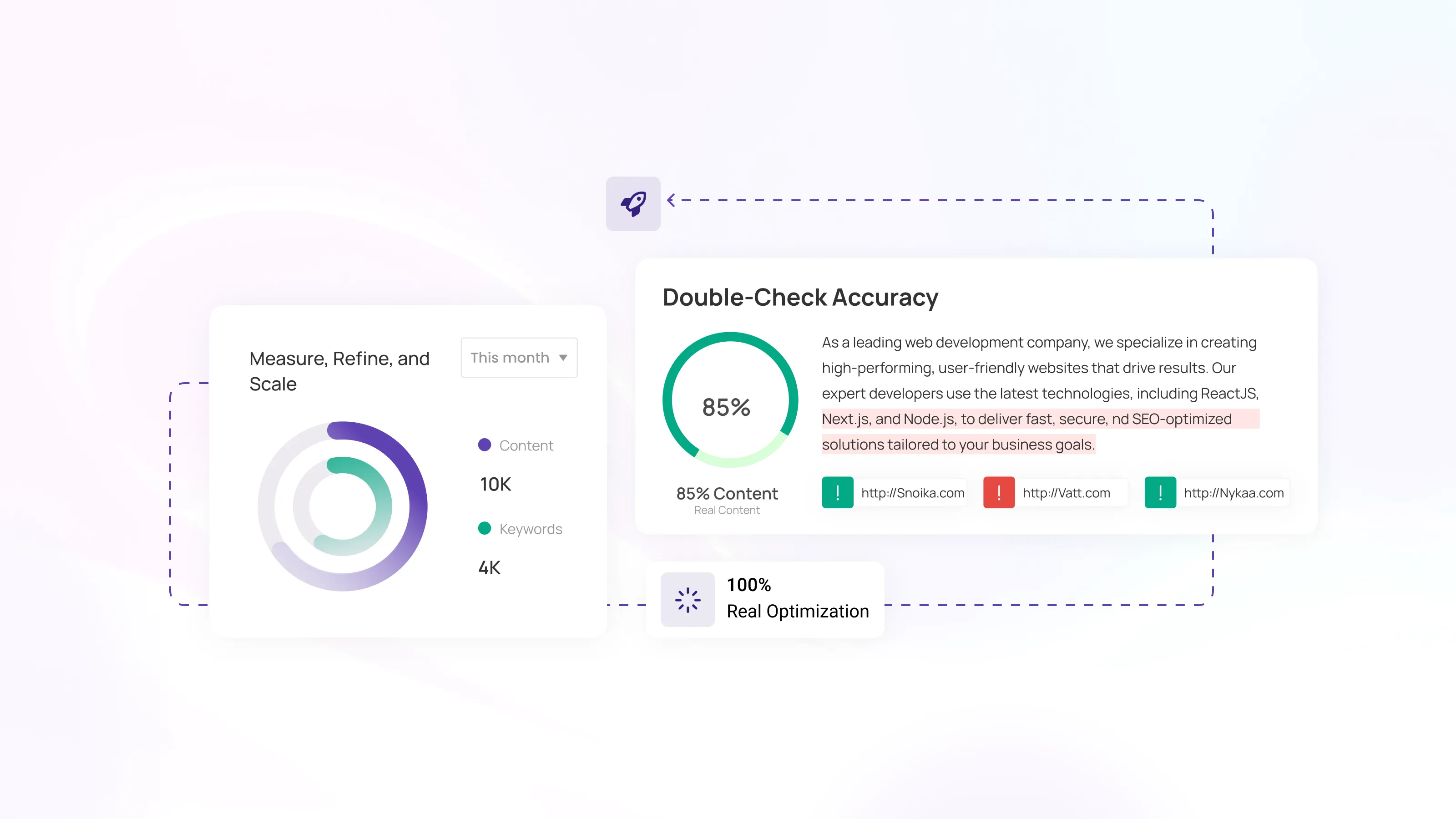Overview
In the next sections, you’ll discover a step-by-step framework for mastering AI content creation. We’ll cover how to set clear content goals, choose the right AI platforms, provide quality prompts, and refine drafts with editing tools. You’ll also learn how to optimize your content for SEO, integrate distribution into your marketing strategy, and measure results to scale effectively. Each step includes practical tips, proven statistics, and tools to help you save time, reduce costs, and maximize ROI with AI-driven workflows.
Step 1: Clarify Your Content Goals
Before you jump into content automation, decide what you want your AI-driven pieces to achieve. Are you aiming for lead generation, customer education, or establishing authority? Different goals may require different writing styles and length.
- Identify your target reader.
- Select the tone (formal, casual, etc.)
- Determine the word count range.
- Track your progress with simple metrics (views, clicks, shares).
Brainstorming Document
Start a simple brainstorming document with topics and formats to keep ideas organized and avoid random outputs. AI content creation uses machine learning to generate or enhance text, audio, or video with minimal human input, from basic suggestions to advanced platforms. To keep your content pipeline fresh, you can use an AI-powered topic generator that relies on data insights and trends to uncover high-impact ideas.
Step 2: Choose Your AI Platform Wisely
Not all AI writing tools are built the same. Some excel at short snippets like social media captions, while others handle longer pieces like case studies. Explore the software’s capabilities before committing. Many tools today also integrate with your existing apps, making content automation smoother.
- Evaluate platform offerings (drafting, editing, SEO suggestions).
- Check if the tool supports your preferred language or style.
- Look for reliability and frequent updates.
- Read user reviews to spot any common weaknesses.
Consider Future Scalability
As you get deeper into AI content creation, you’ll likely expand your usage. Pick a platform that remains relevant for the AI marketing future. Look for features that adapt to new writing trends and integration with emerging technologies. If you're looking to bring your content workflow to the next level, explore how The Best Performing Content Marketing & AI Content Creator for your Business delivers expert prompting, real-time editing, and on-demand strategy - all tailored for marketing growth.
Step 3: Provide Quality Input for Better Output
 An AI tool is only as good as the information you feed it. If you supply vague or cluttered instructions, the platform won’t generate top-notch content. Outline your key points and tone requirements clearly.
An AI tool is only as good as the information you feed it. If you supply vague or cluttered instructions, the platform won’t generate top-notch content. Outline your key points and tone requirements clearly.
- Craft a short prompt or brief outlining your topic.
- Add a background paragraph summarizing the theme.
- Specify the kind of formatting needed (listicles, Q\&A, narrative).
- Mention words or phrases the AI should incorporate (like your brand name or specific industry terms).
Double-Check Accuracy
If your subject is technical or heavily data-driven, offer references or links in your prompt. Note that AI can reduce grammar mistakes by 85%, but it still benefits from having a clear direction.
Step 4: Fine-Tune Your Draft with Editing Tools
Even though AI can generate text quickly, you shouldn’t rely solely on its first draft. Use editing features or separate apps to refine the rhythm of paragraphs, check grammar, and ensure correct spelling.
- Try built-in grammar suggestions.
- Check readability: keep paragraphs short and snappy.
- Look at keyword density, making sure you use “AI content creation” naturally.
- Adjust any jargon or confusing language.
Editing and Proofreading Tips
To polish your drafts, read them aloud, use a grammar checker, and add smooth transitions. An all-in-one tool like The Best Performing Content Marketing & AI Content Creator for your Business covers grammar, readability, and plagiarism scans. By 2025, AI powers 30-40% of online content and helps companies cut costs by 20–30% - with some, like Zalando, saving up to 90% on creation.
Step 5: Optimize Your SEO Strategy
AI content creation becomes more valuable when it aligns with search engine requirements. Research which keywords truly matter for your audience. Then weave them into your content, but keep everything sounding natural.
- Insert your primary keyword (AI content creation) 7–10 times per 1,000 words.
- Sprinkle secondary keywords like “content automation” and “AI marketing future.”
- Add descriptive internal and external links.
- Use headings (H2, H3) with relevant phrases to boost scannability.
To maximize your SEO results, take advantage of tools designed to automate and optimize every step- from keyword suggestions to competitive analysis and ongoing optimization. Learn how to Find the Right Keywords in Minutes - Not Hours - SEO Optimisation Made Easy for your content and streamline your search ranking growth.
Leverage Speed and Engagement Stats
Recent research suggests AI tools can speed up blogging by 20%, while also delivering 25% higher engagement. That means faster turnarounds and more interested readers.
Step 6: Integrate Marketing and Distribution
Your freshly written content has little value if it remains hidden. Tie it to your broader marketing strategy: newsletter blasts, social posts, and website announcements. Also analyze multi-channel sharing to grow your audience.
- Schedule regular publications: weekly, bi-weekly, or monthly.
- Use AI-driven social tools for auto-posting or scheduling.
- A/B test headlines for different segments.
- Reuse content in video or podcast formats.
Planning for the AI Marketing Future
As technology evolves, so do trends - and marketing is no exception. Consider how AI can improve your distribution strategy by automatically identifying which channels to target. Additionally, advanced systems predict best posting times, letting you reach your audience exactly when they’re most active. For a holistic approach that connects content, SEO, and distribution, discover the insights in Brand Marketing vs. Performance Marketing: Which One is Right for You?.
Step 7: Measure, Refine, and Scale
Finally, keep tabs on performance metrics like page views, time on page, and conversions. This data-driven approach reveals which AI-generated content resonates best with your audience.
- Track engagement: clicks, shares, comments.
- Adjust titles or introductions if bounce rates are high.
- Tweak your keyword placements over time.
- Experiment with different content lengths.
For teams managing content at scale or agencies handling multiple campaigns, consider leveraging advanced analytics, automation, and optimization tools built to help you measure and refine performance over time. See how Marketing Agencies: Scale Your SEO Strategy with Snoika empowers you to deliver sustainable growth for every client.
Using Tools to Validate Market Potential
AI-powered tools let you test business ideas fast by creating simple websites, branding, and SEO-friendly content. This way, you can gauge user interest without big risks - and with AI content marketing boosting ROI by up to 30%, the savings and growth potential are huge.
Conclusion
AI content creation can be a game-changer if managed correctly. By establishing clear goals, choosing the right platform, and optimizing each step, you’ll create pieces that strike a chord with your audience -and you’ll do it faster. Toss in the power of SEO and measured refinement, and you’ve got a powerful process. Embrace this progression, keep tracking data, and be ready for new possibilities as AI technology advances.

 An AI tool is only as good as the information you feed it. If you supply vague or cluttered instructions, the platform won’t generate top-notch content. Outline your key points and tone requirements clearly.
An AI tool is only as good as the information you feed it. If you supply vague or cluttered instructions, the platform won’t generate top-notch content. Outline your key points and tone requirements clearly.




